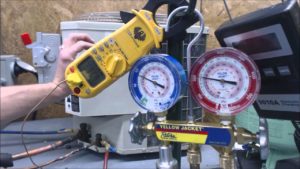How to Tell When Your AC System is Low on Refrigerant
 The refrigerant is the blood of your AC unit. Without it, your AC can’t cool your home thereby technically leaving you in an uncomfortable and sweaty environment. If your AC system is running on low refrigerant levels, it is prone to damage. At times, homeowners can’t tell when their system is low on refrigerant and that is why it is important to read below as we expound on some of the signs to look out for and what you need to do to get things back to normal.
The refrigerant is the blood of your AC unit. Without it, your AC can’t cool your home thereby technically leaving you in an uncomfortable and sweaty environment. If your AC system is running on low refrigerant levels, it is prone to damage. At times, homeowners can’t tell when their system is low on refrigerant and that is why it is important to read below as we expound on some of the signs to look out for and what you need to do to get things back to normal.
Lengthy Cooling Cycles
Homes where the AC unit has inadequate refrigerant levels experience longer cooling cycles than normal. This is because the refrigerant is the heat absorber from the surrounding air and when it is not enough, your AC simply can’t absorb sufficient heat to cool the indoor air to the desired levels.
Warm or Lukewarm Air from the Supply Vent
This is another telltale sign that your refrigerant tank is running empty. When the supply vents blow warm or lukewarm air, your home takes forever to cool off.
Relatively Higher than Normal Utility Bills
Inadequate refrigerant levels make your AC to run much longer than it is necessary to cool your home. For every cycle it runs, it consumes power. This means the longer it does so, the higher your energy bills and the lower the disposable income.
Buildup of Ice on the Refrigerant Line
Take your time and inspect the outdoor unit of your system. In particular, take a closer look on the copper refrigerant line and check whether you can see ice building up on it. If this is the case, then you could be running low on refrigerant.
Whenever the refrigerant level is low, the evaporator coil located on the indoor unit gets too cold thereby causing the cold liquid refrigerant to flow right back through the refrigerant line. This in turn makes the surrounding moisture on the refrigerant line to freeze. Eventually, the refrigerant will get to the compressor on the outdoor unit and this can damage it. Naturally, liquids cannot be compressed and therefore when the refrigerant flows back into the compressor, it is converted into thousands of pounds of hydraulic pressure which may potentially break the plates, rods and valves.
Bubbling or Hissing Noise
A refrigerant unlike gas in a car is never used up. It simply absorbs heat from your indoor air and disperses it outdoors. The only way its levels can reduce is through leakage and this is why a bubbling or hissing noise is indicative of the refrigerant escaping through the copper tubing.
Notify a professional contractor for a deeper analysis if you have done some troubleshooting such as changing of air filters and cleaning the outdoor condenser unit, but you still experience the signs above.

